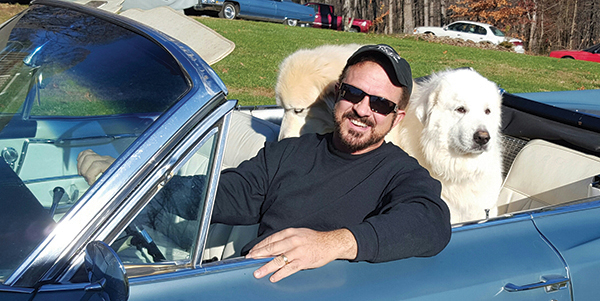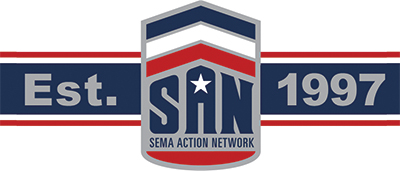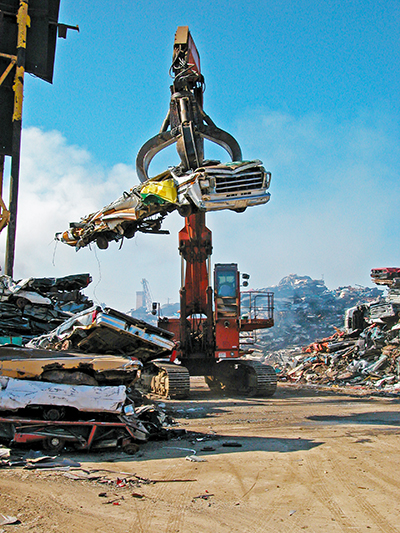SAN 20th Anniversary Part II
* The second part of the SAN’s 20th Anniversary series, continued from the Spring 2017 issue of Driving Force.
 |
|
| A founding member of the SEMA Action Network (SAN), Virginia’s Tom Cox has dedicated more than two decades of legislative service to the automotive community. He is shown here riding proudly with his Great Pyrenees in a ’64 Cadillac convertible. | |
|
|
A slew of challenges quickly consumed the SEMA Action Network (SAN) during its infancy. Before the group could begin impacting legislative efforts nationwide, it first had to prioritize the issues of the day. Identifying and understanding the threats and opportunities affecting the automotive hobby was vital to our future success. The SAN began tracking these priority issues and responding throughout the legislative sessions in each of the 50 states. A unified voice was needed to spread the word about these efforts. Individuals were recruited to engage local car clubs and relevant business interests. It was determined that reliable allies around the country could most effectively reach their communities and spread the word about SAN initiatives.
Initially, fighting state and federal scrappage programs that target vintage cars and trucks struck a chord as the issue that united each niche segment of the hobby. These “Cash for Clunkers” initiatives sought to accelerate the normal demise of vehicles through the immediate retirement of older models which were then typically crushed into blocks of scrap metal. Such programs rely on the premise that by scrapping older rides the state will realize increased emissions reductions.
“It was widely documented in state after state that the desired result was rarely achieved, as these programs were considered and then discarded as largely symbolic gestures,” said SEMA Vice President of Government Affairs Steve McDonald. “In the early days, the SAN united around the notion that America safeguards its artistic and architectural heritage against indiscriminate destruction and our automotive heritage deserved the same protection.”
 As auto enthusiasts learned of the struggle with “clunker” proposals, they began stepping up as advocates for the cause. In 1998, working with the SAN, Bill Buck and the Arizona Automobile Hobbyist Council educated Arizona legislators and regulators about the inefficiencies of scrappage programs and the comparative advantages of voluntary emissions-system repair and upgrade. As a result, the first-ever state law authorizing voluntary repair and retrofit was signed into law as an alternative to crushing vehicles. “The fact that government would crush vintage vehicles but continue to allow stationary source polluters to go unchecked was an ineffective way to improve air quality!” exclaimed antique aficionado Tom Cox.
As auto enthusiasts learned of the struggle with “clunker” proposals, they began stepping up as advocates for the cause. In 1998, working with the SAN, Bill Buck and the Arizona Automobile Hobbyist Council educated Arizona legislators and regulators about the inefficiencies of scrappage programs and the comparative advantages of voluntary emissions-system repair and upgrade. As a result, the first-ever state law authorizing voluntary repair and retrofit was signed into law as an alternative to crushing vehicles. “The fact that government would crush vintage vehicles but continue to allow stationary source polluters to go unchecked was an ineffective way to improve air quality!” exclaimed antique aficionado Tom Cox.
 |
|
| In its earliest years, the SAN’s struggle with “clunker” proposals helped unite a growing force in seeking alternatives to crushing vehicles. | |
|
|
Currently president of the Antique Automobile Club of America, Cox came to the blossoming SAN force as a veteran combatant on the legislative battlefield. He recalled, “Even before the Driving Force newsletters had been sent out and the SAN’s name coined, I’d become involved in SEMA’s government affairs effort through the anti-scrappage efforts. At first, I was a lone advocate. There were some individuals out there doing advocacy for the hobby at the time, but they were disorganized and few and far between.” Cox helped form several car club councils in Virginia which eventually covered the entirety of his home state. Soon enough, Cox, along with his contacts and cohorts Fred Fann and Hal Hartel, had lines of communication set up between regions, area car club councils and the SAN to ensure our voices were heard by legislators.
Unfair exhaust noise violations for aftermarket exhaust systems also plagued the automotive community for years. Fueled by The Fast & The Furious franchise, young enthusiasts were targeted at the height of the import “tuner” craze in the early ’00s.
“Law enforcement officers would pull me over and tell me my pipes were too loud,” explains the first SAN Director Brian Caudill. “Of course, they could never tell me what the stock muffler sounded like.”
The growing problem made it clear that a fair and reasonable exhaust noise standard would need to be created to combat the subjective policies being enforced in a number of jurisdictions. SEMA Vice President of Government Affairs Steve McDonald worked with the California legislature and the California Highway Patrol to draft and pass such a proposal. “For years, the enforcement policy used by law enforcement deemed nearly all exhaust system modifications illegal, even where the noise levels were not excessive or unusual,” explained McDonald. “That policy left exhaust system manufacturers, dealers and their customers without recourse.”
Well-deserved credibility was earned by the SAN when California adopted the new exhaust system law in 2002. The state’s legal noise limit was set at 95 decibels under a fair test standard. In 2003, Maine enacted the law followed by Montana in 2007. Through the approved testing procedure, motorists in these states could finally fight citations issued by law enforcement officers by proving their vehicles complied with state noise standards. The law also allows courts to dismiss citations for exhaust systems that had been tested and for which a certificate of compliance had been issued. “By establishing this evenhanded testing process, this program served to benefit consumers who favor state-of-the-art products, the aftermarket industry which markets them, and even police officers who are charged with enforcing the law,” McDonald added. Ultimately, the program resulted in the certification of approximately 90% of tested vehicles to be in compliance with the law.
Legislative triumphs early on bred a successful reputation for SEMA’s grassroots initiative. “The SAN represented a great opportunity to reach a wider scope of enthusiasts and synergize the interests of hobbyists with the automotive industry,” Cox recalled. “However, the group had to prove itself to the communities like mine. There was a suspicion about corporate influence over hobby groups that would favor new revenue streams rather than the people.” Thankfully, those fears were quickly dispersed and made way for real progress. In fact, SEMA member businesses began trusting that their active involvement, coupled with consumer involvement, would expand opportunities for both. In particular, the SEMA-supported Automotive Restoration Market Organization (ARMO) took a keen interest in the SAN and actively promoted its growth and development. Names like Jeff Moses, Steve Ames, Corky Coker, Jim Wirth, Matt Agosta and Kathy Bybee-Hartzell were among those who fully supported the group’s advocacy mission. They acted as program mentors by challenging the SAN staff to find unique solutions to long-standing problems.
Stay tuned for the next issue of Driving Force for the third installment of our look back at the SAN’s 20-year history.
